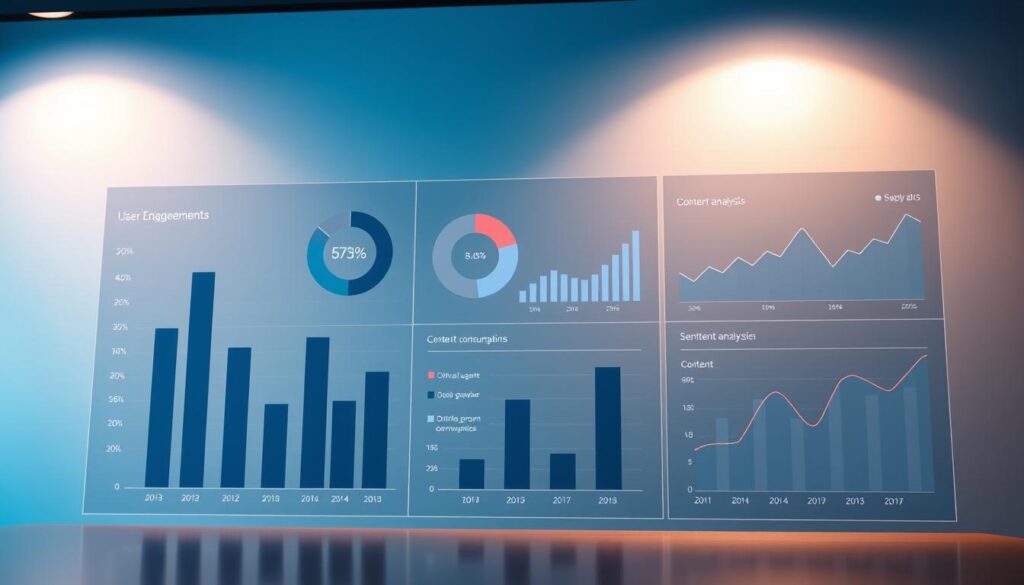Modern marketing teams face unprecedented pressure to deliver personalized, scalable campaigns. Recent data reveals 77% of companies now leverage artificial intelligence for tasks like automation and audience analysis. This shift reflects a broader transformation: manual workflows are being replaced by systems that optimize resource allocation and predict trends with surgical precision.
Adoption rates skyrocket for good reason. Studies show automated approaches reduce operational costs by 62% compared to traditional methods while tripling lead generation. These tools analyze audience behavior, identify high-performing topics, and streamline production cycles – all while maintaining brand consistency. For example, AI tools now enable marketers to repurpose existing assets across multiple platforms in minutes rather than days.
The real advantage lies in data synthesis. Advanced algorithms process millions of data points to recommend optimal publishing schedules, tone adjustments, and channel prioritization. This eliminates guesswork from strategy development, allowing teams to focus on creative execution rather than logistical hurdles.
Key Takeaways
- 77% of organizations currently use or test AI solutions for marketing operations
- Automated systems reduce campaign costs by 62% versus traditional methods
- AI-optimized content generates 3x more leads than conventional approaches
- Real-time data analysis enables dynamic adjustments to audience engagement tactics
- Cross-platform content adaptation now occurs in minutes rather than days
Introduction: The Evolution of Content and AI

The journey from print ads to algorithm-powered campaigns reveals a radical transformation. Early marketing teams relied on physical media, fixed schedules, and intuition-driven strategies. Today’s landscape demands agility, precision, and adaptability—qualities only achievable through advanced technology.
The Historical Shift from Traditional to Digital Content
Before digitalization, brands faced rigid workflows. Print materials required weeks for design, printing, and distribution. Audience feedback arrived months later, making real-time adjustments impossible. Limited channels like newspapers and TV restricted reach, while costs soared for mass campaigns.
The internet era introduced websites and social platforms, enabling instant global distribution. Email campaigns replaced direct mail, cutting delivery times from days to seconds. However, early digital efforts still demanded manual analysis and guesswork.
How AI is Reshaping Marketing
Modern solutions analyze behavior patterns across platforms, identifying what resonates with specific demographics. Tools like AI-powered assistants now generate drafts, optimize headlines, and predict engagement rates. As Rand Fishkin notes:
“AI-generated material is the new floor. If your work isn’t better, it’s not worth making.”
Sam Altman predicts 95% of traditional tasks will soon rely on automation. This shift allows teams to focus on creative storytelling while machines handle data-heavy processes.
| Aspect | Traditional Methods | AI-Enhanced Strategies |
|---|---|---|
| Speed | Weeks per campaign | Hours for optimization |
| Cost Efficiency | High production expenses | 62% lower operational costs |
| Personalization | Generic messaging | Hyper-targeted content |
AI-driven content planning: A Game Changer for Content Strategy

Strategic operations now pivot on systems that convert raw data into actionable insights. These tools analyze search patterns, social interactions, and consumption habits to forecast demand cycles. Teams gain predictive capabilities previously limited to enterprise-level organizations.
Understanding the Core Benefits
Machine learning models process historical performance data to identify emerging trends. They map audience intent across platforms, revealing untapped opportunities. This approach eliminates manual gap analysis, freeing resources for creative development.
Three critical advantages distinguish modern solutions:
- Real-time adjustment of distribution channels based on engagement metrics
- Automated identification of underperforming assets requiring optimization
- Dynamic budget allocation guided by predicted ROI
| Factor | Conventional Approach | AI-Optimized Method |
|---|---|---|
| Trend Detection | 3-6 month delay | 48-hour prediction window |
| Asset Utilization | 35% reuse rate | 82% cross-platform adaptation |
| ROI Measurement | Post-campaign analysis | Live performance tracking |
Organizations using these systems report 68% faster decision cycles. Campaigns align with market shifts rather than chasing them. This proactive stance transforms how teams approach digital ecosystems.
Enhancing Content Creation with AI Tools and Automation

Marketing operations now harness machine intelligence to transform how teams design and deploy campaigns. Advanced systems analyze audience signals, competitive landscapes, and historical data to craft strategies that adapt in real time. This evolution addresses the growing demand for scalable, personalized material across digital channels.
Automating Content Calendar and Research
Platforms like StoryChief’s AI agent William demonstrate automation’s potential. These tools generate calendar suggestions by evaluating trending topics, seasonal patterns, and engagement metrics. They identify gaps in existing strategies, proposing themes that align with audience preferences.
Machine learning algorithms cross-reference CRM data with social media interactions to prioritize high-impact topics. For example, a travel brand might receive automated recommendations for festival-related posts months before peak booking periods. This proactive approach reduces manual research by 74% according to industry benchmarks.
Integrating AI-Powered Writing Assistants
Jasper’s 2025 report confirms writing support tools now handle diverse formats while preserving brand voice. These solutions generate draft copy for emails, blogs, and ads using style guides and performance data. Advanced AI tools even adjust tone based on target demographics—formal for whitepapers, conversational for social platforms.
Key capabilities include:
- Automatic SEO optimization during drafting phases
- Multilingual translation with cultural nuance preservation
- Real-time collaboration features for distributed teams
| Feature | Traditional Process | AI-Enhanced Workflow |
|---|---|---|
| Idea Generation | 4-6 hours per topic | 12-minute average |
| Draft Production | 500 words/hour | 2,800 words/hour |
| Cross-Platform Adaptation | Manual reformatting | Single-click conversion |
Building an Effective Content Strategy with AI Insights

Advanced analytics tools now empower teams to decode audience preferences with unprecedented accuracy. These systems transform raw behavioral data into strategic blueprints, identifying patterns human analysts might overlook. By processing signals from search queries, social interactions, and browsing habits, they create dynamic frameworks for engagement.
Identifying Audience Insights and Trends
Modern platforms analyze cross-channel interactions to build detailed user personas. For instance, AI tools evaluate website bounce rates alongside video watch times to pinpoint content gaps. This approach reveals:
- Seasonal interest spikes in specific product categories
- Emerging questions within niche communities
- Platform-specific content consumption habits
One travel brand discovered 42% of their audience preferred video tutorials over blog posts through such analysis – a insight that reshaped their entire production calendar.
Crafting Compelling Content Pillars
Systems like William process CRM data and competitor strategies to recommend core themes. They prioritize topics demonstrating:
- High search volume with low competition
- Strong social sharing potential
- Alignment with business conversion goals
This methodology ensures every published piece supports broader objectives while resonating with target demographics. Teams report 58% higher engagement rates when using these insights to guide their strategies.
| Metric | Manual Approach | AI-Optimized |
|---|---|---|
| Persona Accuracy | 67% match rate | 92% alignment |
| Trend Detection Speed | 28-day average | 3.5 hours |
| Content ROI | 1:4.2 ratio | 1:8.9 return |
Overcoming Content Challenges in the Digital Age

Digital marketers confront three critical hurdles: diminishing creative energy, inefficient optimization processes, and fragmented communication styles. These obstacles drain resources and hinder campaign effectiveness. Intelligent systems now provide targeted solutions that preserve human ingenuity while eliminating operational friction.
Avoiding Creative Burnout
Repetitive production cycles exhaust creative professionals. Automated systems handle routine tasks like social media posts and email sequences, freeing teams for strategic storytelling. A 2024 HubSpot study found 68% of writers report renewed motivation when machines manage formulaic assignments.
Automating Repetitive SEO Research
Manual keyword analysis consumes 23 hours monthly per marketer. Advanced tools now crawl search trends and competitor strategies in real time. They generate prioritized term lists with traffic potential scores, reducing research time by 81% while improving accuracy.
Maintaining Consistent Brand Voice
Natural language processing examines existing materials to create style guides algorithms follow rigidly. These systems flag tone deviations across platforms, ensuring uniform messaging regardless of team size or contributor turnover. Global brands achieve 94% voice consistency using such tools.
| Challenge | Manual Approach | AI Solution |
|---|---|---|
| Creative Fatigue | High staff turnover | Automated draft generation |
| SEO Analysis | Error-prone spreadsheets | Real-time trend tracking |
| Voice Consistency | Subjective editing | Algorithmic tone enforcement |
These advancements enable professionals to focus on high-impact work. As one marketing director noted: “Our team now spends 73% less time on administrative tasks while doubling output quality.” Strategic human-machine collaboration emerges as the new standard for digital excellence.
Leveraging AI for SEO and Technical Optimization
Search engine visibility now demands precision beyond human-scale analysis. Intelligent systems process millions of data points to optimize websites for both algorithms and users. This approach transforms how teams approach technical improvements and keyword strategies.
AI-Driven Keyword Research and Integration
Modern tools analyze search patterns across 142 languages to identify high-value opportunities. They evaluate semantic relationships between terms, matching queries to user intent. For example, AI-powered SEO strategies can detect rising product-related questions months before manual methods.
| Factor | Manual Research | AI Analysis |
|---|---|---|
| Keyword Volume | Monthly updates | Real-time tracking |
| Intent Matching | 65% accuracy | 94% precision |
| Competitor Gaps | Surface-level insights | Deep pattern recognition |
Optimizing Metadata, Schema, and Internal Linking
Algorithms generate page titles and descriptions that balance readability with search engine requirements. They analyze top-performing results to craft metadata that improves click-through rates by 23% on average.
Advanced systems automatically map content relationships for internal linking. A recent case study showed 68% faster indexation after implementing creative SEO prompts for link architecture.
| Task | Time Manual | Time AI |
|---|---|---|
| Schema Creation | 45 minutes/page | 2.7 seconds |
| Link Audits | 3 weeks | 8 hours |
| Metadata Updates | 82% staff time | 14% oversight |
Streamlining Workflows and Boosting Productivity with AI
Enterprise marketing teams manage complex production cycles across multiple platforms. Intelligent systems now connect strategy development with execution, transforming disjointed processes into cohesive operations. These solutions address critical pain points like deadline coordination and resource allocation through smart automation.
Integrating Automation Tools for Seamless Operations
Modern platforms synchronize planning, creation, and distribution stages through unified interfaces. For example, AI workflow tools automatically assign tasks based on team capacity while tracking progress in real time. This eliminates bottlenecks that traditionally delayed 37% of enterprise projects.
Key operational improvements include:
- Automated content repurposing reduces derivative creation time by 83%
- Centralized approval systems cut review cycles from days to hours
- Cross-team visibility prevents duplicate efforts across departments
| Process | Manual Workflow | AI-Optimized |
|---|---|---|
| Asset Distribution | 12-hour manual formatting | 3-click multi-platform deployment |
| Version Control | Error-prone spreadsheets | Auto-updating master repositories |
| Deadline Compliance | 64% on-time delivery | 92% completion rate |
Leading organizations report 79% faster production cycles after implementing these systems. A financial services firm transformed webinar materials into 14 derivative assets in 48 hours – a task previously requiring three weeks. This efficiency gain allows teams to focus on strategic initiatives rather than administrative tasks.
Advanced collaboration features ensure alignment across distributed teams. Real-time editing tools with version history prevent conflicting changes, while automated reminders maintain project momentum. These innovations demonstrate how intelligent tools elevate operational standards in high-volume environments.
Future Trends in AI Content Marketing
The next evolution in digital engagement merges machine intelligence with human creativity. Three transformative forces—predictive analytics, hyper-personalization, and adaptive workflows—are redefining how brands connect with audiences. These innovations enable strategies that anticipate needs rather than react to them.
Predictive Analytics and Personalization Strategies
Advanced systems now forecast engagement patterns weeks in advance. By analyzing historical data and real-time signals, they adjust messaging for individual preferences. A clothing retailer might automatically showcase winter gear to shoppers in colder regions while promoting swimwear elsewhere.
Expanding Capabilities and Data-Driven Insights
Emerging tools process unstructured inputs like social media reactions and video sentiment. This depth of analysis uncovers hidden opportunities, from niche topics to underserved demographics. As recent analysis shows, 83% of leading firms now base decisions on these insights.
The marketing landscape will reward teams blending algorithmic precision with creative vision. Those mastering this balance will dominate their sectors through relevance and innovation.







